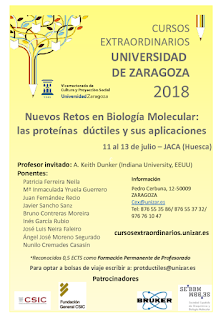My notes on the second and final day of the 1st Spanish Simposium on Physiology & Cereal Breeding: http://networks.iamz.ciheam.org/cerealsnetwork/en/summaries.html
Omar Vergara-Diaz, Univ.Barcelona
He presents preliminary results on yield
predictive models in water stress and control conditions based on metabolite
profiles of leaves and spikes of field-grown wheat inferred from hyperspectral readings.
He has recently presented this results at http://adsabs.harvard.edu/abs/2017AGUFM.B51A1782V.
Shawn Kefauver, Univ. Barcelona
& CIMMYT Africa
Inès Zouari, INAT, Tunisia
She presents results on drought stress impact
on durum wheat. Her work involves the development and use of drought
(susceptibility and tolerance) indices, which were evaluated to ascertain their
value in breeding. She concludes that selection must be based on different
combinations of indices depending on whether breeding targets irrigated or
rainfed materials. In all cases the number of spikes and high biomass seem
diagnostic as traits to be selected.
John Foulkes, University of Nottingham-UK
His keynote is about exploring genetic
diversity for rooting traits and tolerance of water & N stresses in wheat. He
starts by explaining what N-use efficiency (NUE) is. He mentions that deep
roots help plants under drought and that is reflected in C12/13 isotope ratios.
He also mentions RootNav (http://www.plant-image-analysis.org/software/rootnav) and ImageJ (https://imagej.nih.gov/ij) which they have used to study root phenotypes (crown root angle, root
length density) in lab experiments, observing high heritabilities in DH
populations and significant association to yield in rainfed trials. He shows
nice pics of aerenchyma formation in roots under drought.
Marta Lopes, CIMMYT, Turkey
She talks about winter wheat physiology and the
optimization of resilience to a changing environment in rainfed crop systems of
Turkey and Iran. She shows field data on grain yield when plots are exposed to
heat spells and drought before and after heading. She mentions an article
recently published in FPS, but I could not find, sorry. During questions, she
explains that there is a database of CIMMYT genotypes so that anyone can query
and order seeds.
Mariona Martínez-Subira, Univ. Lleida
She talks about her work, in collaboration with
CSIC and SemillasBatlle, synthesis of bioactive compounds (beta-glucans,
arabinoxylans) in barley during grain filling in response to late abiotic
stress. She reports that growth under plastics reproduces terminal heat stress
and that stress affects the composition of bioactive compounds.
Rubén Vicente, presents work done at Univ.
Barcelona
Talks about C and N metabolism in laminar and
non-laminar photosynthetic organs under contrasting water regimes in low- and high-yielding
durum wheat cultivars (Sebastian & Pelayo) grown in ITACyL, Valladolid for
3 seasons. Under water stress they observe reduction of biomass, grain yield and
senescence.
Damiano Martignano, CRAG, Barcelona
His talk describes approaches for Cas9 genome
editing in Sorghum, which he applies
to brassinosteroids (BS) engineering. He builds on previous observations in Arabidopsis thaliana showing that
increasing BS receptors increases performance under drought. He mentions also
the uzu mutant in barley, which is
related. His protocol takes 10-14 weeks. They are producing NILs from Iberian
landraces obtained from INIA. They are building a facility to perform high-throughput
phenotyping (DroughtSpotter and PHENOSPEX).
David Soba, Univ. Navarra
He talks about the effect of elevated [CO2] on durum
wheat grain quality during grain filling. Concludes that yield is increased, as
well as gluten proteins. In contrats, free amino acids are reduced.
Elena Prats, IAS-CSIC, Córdoba
She delivers a keynote on the physiological
dysfunctions of stomata (lock-up) under fungal infection and drought which
affect both resistance to disease and drought responses. She explains a series
of experiments in which plants were supplied with ABA and exposed to fungi,
that allowed her team to conclude that infection does affect the stomatal
movements. This behavior is part of what has been called hypersensitive
response, which has been described in https://academic.oup.com/jxb/article/59/3/501/573771.
Francisco Ciudad- Bautista, ITACyL, Valladolid
Reports on the current incidence of fly Oscinella frit, which affects both wheat
and barley, in Castilla y León, Spain. He shows fly curves and pictures of
larvae and pupae in grains and explains how the symptoms can be distinguished
from other diseases.
Yésica Pallavicini, ITACyL
She presents preliminary results on the use of
aerial platforms and spectral indices to monitor the spread of yellow rust in bread wheat along the growing
season.

